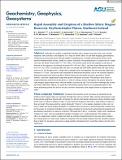Files in this item
Rapid assembly and eruption of a shallow silicic magma reservoir, Reyðarártindur Pluton, southeast Iceland
Item metadata
| dc.contributor.author | Rhodes, E. L. | |
| dc.contributor.author | Barker, A. K. | |
| dc.contributor.author | Burchardt, S. | |
| dc.contributor.author | Hieronymus, C. F. | |
| dc.contributor.author | Rousku, S. N. | |
| dc.contributor.author | McGarvie, D. W. | |
| dc.contributor.author | Mattsson, T. | |
| dc.contributor.author | Schmiedel, T. | |
| dc.contributor.author | Ronchin, E. | |
| dc.contributor.author | Witcher, T. | |
| dc.date.accessioned | 2021-12-14T16:30:14Z | |
| dc.date.available | 2021-12-14T16:30:14Z | |
| dc.date.issued | 2021-11-08 | |
| dc.identifier | 276976848 | |
| dc.identifier | a0e7a693-0e0e-47f4-b0d3-5b3636d81002 | |
| dc.identifier | 000723103400008 | |
| dc.identifier | 85119830694 | |
| dc.identifier.citation | Rhodes , E L , Barker , A K , Burchardt , S , Hieronymus , C F , Rousku , S N , McGarvie , D W , Mattsson , T , Schmiedel , T , Ronchin , E & Witcher , T 2021 , ' Rapid assembly and eruption of a shallow silicic magma reservoir, Reyðarártindur Pluton, southeast Iceland ' , Geochemistry, Geophysics, Geosystems , vol. 22 , no. 11 , e2021GC009999 . https://doi.org/10.1029/2021GC009999 | en |
| dc.identifier.issn | 1525-2027 | |
| dc.identifier.other | ORCID: /0000-0003-0717-4014/work/104252858 | |
| dc.identifier.uri | https://hdl.handle.net/10023/24511 | |
| dc.description | Knut och Alice Wallenbergs Stiftelse (Knut and Alice Wallenberg Foundation). Grant Number: KAW 2017.0153 Royal Swedish Academy of Sciences (KVA). Grant Number: GS2019–0024 Center of Natural Hazards and Disaster Science. | en |
| dc.description.abstract | Although it is widely accepted that shallow silicic magma reservoirs exist, and can feed eruptions, their dynamics and longevity are a topic of debate. Here, we use field mapping, geochemistry, 3D pluton reconstruction and a thermal model to investigate the assembly and eruptive history of the shallow Reyoarartindur Pluton, southeast Iceland. Primarily, the exposed pluton is constructed of a single rock unit, the Main Granite (69.9-77.7 wt.% SiO2). Two further units are locally exposed as enclaves at the base of the exposure, the Granite Enclaves (67.4-70.2 wt.% SiO2), and the Quartz Monzonite Enclaves (61.8-67.3 wt.% SiO2). Geochemically, the units are related and were likely derived from the same source reservoir. In 3D, the pluton has a shape characterized by flat roof segments that are vertically offset and a volume of >2.5 km3. The pluton roof is intruded by dikes from the pluton, and in two locations displays depressions associated with large dikes. Within these particular dikes the rock is partially to wholly tuffisitic, and rock compositions range from quartz monzonite to granite. We interpret these zones as eruption-feeding conduits from the pluton. A lack of cooling contacts throughout the pluton indicates rapid magma emplacement and a thermal model calculates the top 75 m would have rheologically locked up within 1,000 years. Hence, we argue that the Reyoarartindur Pluton was an ephemeral part of the wider plumbing system that feeds a volcano, and that timeframes from emplacement to eruption were rapid. | |
| dc.format.extent | 26 | |
| dc.format.extent | 9886372 | |
| dc.language.iso | eng | |
| dc.relation.ispartof | Geochemistry, Geophysics, Geosystems | en |
| dc.subject | Volcanic-plutonic connection | en |
| dc.subject | Magma mixing | en |
| dc.subject | Magma chamber | en |
| dc.subject | Eruption trigger | en |
| dc.subject | Conduit | en |
| dc.subject | GB Physical geography | en |
| dc.subject | DAS | en |
| dc.subject.lcc | GB | en |
| dc.title | Rapid assembly and eruption of a shallow silicic magma reservoir, Reyðarártindur Pluton, southeast Iceland | en |
| dc.type | Journal article | en |
| dc.contributor.institution | University of St Andrews. School of Earth & Environmental Sciences | en |
| dc.identifier.doi | 10.1029/2021GC009999 | |
| dc.description.status | Peer reviewed | en |
This item appears in the following Collection(s)
Items in the St Andrews Research Repository are protected by copyright, with all rights reserved, unless otherwise indicated.

